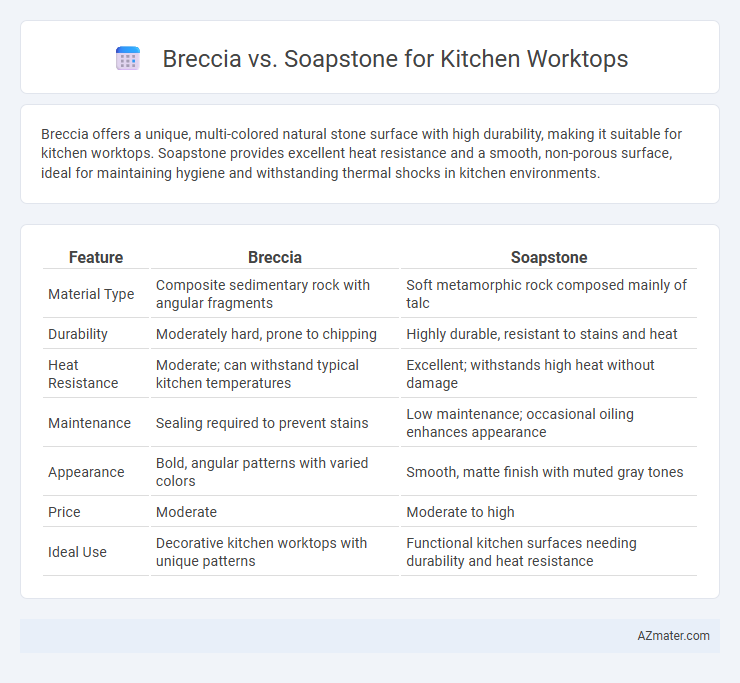Breccia offers a unique, multi-colored natural stone surface with high durability, making it suitable for kitchen worktops. Soapstone provides excellent heat resistance and a smooth, non-porous surface, ideal for maintaining hygiene and withstanding thermal shocks in kitchen environments.
Table of Comparison
| Feature | Breccia | Soapstone |
|---|---|---|
| Material Type | Composite sedimentary rock with angular fragments | Soft metamorphic rock composed mainly of talc |
| Durability | Moderately hard, prone to chipping | Highly durable, resistant to stains and heat |
| Heat Resistance | Moderate; can withstand typical kitchen temperatures | Excellent; withstands high heat without damage |
| Maintenance | Sealing required to prevent stains | Low maintenance; occasional oiling enhances appearance |
| Appearance | Bold, angular patterns with varied colors | Smooth, matte finish with muted gray tones |
| Price | Moderate | Moderate to high |
| Ideal Use | Decorative kitchen worktops with unique patterns | Functional kitchen surfaces needing durability and heat resistance |
Introduction to Breccia and Soapstone Worktops
Breccia worktops feature a distinctive, fragmented stone pattern that creates a dramatic and elegant look, commonly sourced from marble or limestone varieties with high durability. Soapstone worktops are composed primarily of talc, offering exceptional heat resistance and a smooth, matte finish that darkens over time, enhancing its natural appeal. Both materials provide unique aesthetic and functional qualities ideal for kitchen surfaces, with Breccia emphasizing bold visual impact and Soapstone valued for its resilience and ease of maintenance.
Composition and Formation of Breccia
Breccia, composed of angular rock fragments cemented by a finer matrix, forms through processes such as sedimentary deposition, volcanic activity, or tectonic faulting, resulting in a distinctive, fragmented appearance. Soapstone, primarily made of talc, originates from metamorphic alteration of ultramafic rocks, giving it a smooth texture and heat-resistant properties. The contrasting formation processes of breccia and soapstone influence their durability, porosity, and aesthetic suitability for kitchen worktops.
What is Soapstone? Key Characteristics
Soapstone is a natural metamorphic rock composed primarily of talc, known for its smooth, soft texture and heat resistance, making it ideal for kitchen worktops. Its key characteristics include a non-porous surface that resists stains and bacterial growth, exceptional durability, and the ability to darken and develop a unique patina over time. Soapstone's natural heat retention also allows hot pots and pans to be placed directly on the surface without damage, unlike many other countertop materials.
Aesthetic Differences: Breccia vs Soapstone
Breccia countertops showcase a striking, dramatic aesthetic with bold, irregular patterns composed of fragmented stones in varied colors, creating a vibrant and unique focal point in kitchen design. Soapstone offers a more uniform, smooth appearance with subtle veining and a matte finish that lends a classic, understated elegance and a warm, natural feel. While Breccia emphasizes dynamic visual complexity, Soapstone prioritizes timeless simplicity and a soft, tactile surface ideal for traditional and modern kitchens alike.
Durability and Strength Comparison
Breccia offers exceptional durability with its natural stone composition, providing high resistance to scratches and heat, making it ideal for heavy kitchen use. Soapstone, though softer and less resistant to scratching, excels in thermal stability and can withstand high temperatures without damage. In terms of strength, Breccia is generally harder and more robust, while Soapstone requires regular maintenance to prevent surface wear but gains character through natural aging.
Maintenance and Care Requirements
Breccia kitchen worktops require regular sealing to prevent stains and maintain their polished appearance, as their porous nature makes them susceptible to moisture and oil absorption. Soapstone offers low maintenance benefits, being naturally resistant to stains, heat, and bacteria, with occasional oiling enhancing its dark patina over time. Both materials benefit from gentle cleaning with mild soap and water, but Breccia demands more vigilant upkeep to avoid etching and discoloration.
Heat and Stain Resistance: Which Performs Better?
Breccia offers superior heat resistance due to its natural stone composition, allowing it to withstand high temperatures from pots and pans without damage. Soapstone is also heat-resistant and less prone to thermal shock, but its softer texture makes it more susceptible to scratches and stains if not properly sealed. When comparing stain resistance, breccia generally performs better as it is less porous than soapstone, reducing the risk of absorbing oils and liquids commonly found in kitchen environments.
Cost Analysis: Breccia vs Soapstone Worktops
Breccia worktops typically range from $70 to $120 per square foot, reflecting their exotic appearance and rarity, while soapstone costs average between $65 and $100 per square foot due to its durability and heat resistance. Installation expenses for breccia are usually higher because of its brittleness and specialized cutting requirements, whereas soapstone's softer composition allows for easier, less costly installation. Long-term maintenance costs favor soapstone, as it is less prone to staining and chipping compared to breccia, reducing the need for frequent repairs and sealants.
Environmental Impact and Sustainability
Breccia and soapstone differ significantly in environmental impact and sustainability for kitchen worktops, with soapstone being a more eco-friendly choice due to its natural abundance and minimal processing requirements. Breccia, a type of marble, involves intensive quarrying and higher energy consumption in extraction and finishing, increasing its carbon footprint. Soapstone offers durability and chemical resistance with less environmental degradation, making it preferable for sustainable kitchen design.
Which is Best for Your Kitchen? Breccia or Soapstone
Breccia offers striking visual appeal with its unique veining and polished finish, making it ideal for kitchens prioritizing aesthetics and durability; however, it requires regular sealing to prevent staining. Soapstone is highly resistant to heat, scratches, and stains, offering a low-maintenance surface that naturally darkens over time, suited for busy kitchens demanding resilience and ease of care. Choosing between Breccia and Soapstone depends on your preference for visual impact versus practicality, with soapstone favored for functionality and breccia for sophisticated elegance.

Infographic: Breccia vs Soapstone for Kitchen Worktop
 azmater.com
azmater.com